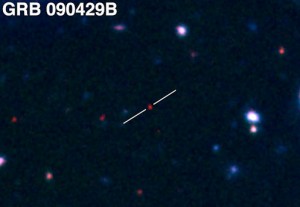MAUNA KEA, Hawaii – A gamma ray burst detected near the edge of the observable universe has astronomers around the world excited.
Images taken from Hawaii’s Gemini North telescope atop Mauna Kea reveals the infrared afterglow of this powerful burst.
It is likely to be the most distant gamma ray burst ever detected, having occurred within a half a billion years of the Big Bang. It may even be the most distant object ever observed in the universe, say scientists.
“Like any finding of this sort there are uncertainties,” said the study’s principal investigator Antonino Cucchiara in a media release. “However, if I were in Vegas, I would never bet against the odds that this is the most distant GRB ever seen and we estimate that there is even a 23% chance that it is the most distant object ever observed in the universe.”
The finding was announced last week at the American Astronomical Society meeting in Boston Massachusetts. The burst, which is a consequence of the death of a massive star, was first spied by NASA’s Swift satellite in April 2009.
The subsequent afterglow was detected only at infrared wavelengths using the Gemini North telescope.
From the Gemini media release:
The research team, led by former Penn State University graduate student Antonino Cucchiara (now at the University of California at Berkeley), marshaled the extreme vision of Gemini and other large ground- and space-based telescopes to understand the object. According to Cucchiara, “Gemini was the right telescope, in the right place, at the right time. The data from Gemini was instrumental in allowing us to reach the conclusion that the object is likely the most distant GRB ever seen.” If the team is correct, this light embarked on its journey some 13.1 billion years ago or about 520 million years after the Big Bang – surprisingly close to the advent of the Big Bang 13.7 billion years ago. Additionally, this GRB appears to be normal, leading to the conclusion that it is not the consequence of the very first generation of stars formed in the universe. The implication is that the early, extremely young universe was already a busy star factory.
Reaching the conclusion that GRB 090429B is so distant was not easy and is one reason it has taken two years for this result to be announced. “Ideally we would have gathered a spectrum to measure the distance precisely, but we were foiled at the last minute when the weather took a turn for the worse on Mauna Kea. Since GRB afterglows fade so quickly, we never got a second chance,” said Derek Fox, Cucchiara’s advisor for his graduate research at Penn State University.
However, by using the existing data from Gemini and combining it in innovative ways with wider-field images from the United Kingdom Infrared Telescope (also on Hawaii’s Mauna Kea), the team was able to estimate the redshift of GRB 090429B with a high degree of confidence. “Also, the fact that we were never able to detect anything in the spot where we saw the afterglow in the Gemini data gave us the missing link in converging on this extremely high redshift estimate,” said Cucchiara. “We looked with Gemini, the Hubble Space Telescope and also with the Very Large Telescope in Chile and never saw anything once the afterglow faded. This means that this GRB’s host galaxy is so distant that it couldn’t be seen with any existing telescopes. Because of this, and the information provided by the Swift satellite, our confidence is extremely high that this event happened very, very early in the history of our universe.”
The paper based on this work is accepted in The Astrophysical Journal Authors include: Antonino Cucchiara (Penn State University/UC Berkeley), Derek Fox (Penn State University), Andrew Levan (University of Warwick, UK) and Nial Tanvir (University of Leicester, UK) and 31 astronomers from around the world. A preprint of the paper can be found here.
 RIGHT: Gemini Observatory color composite image of the afterglow of GRB 090429B – a candidate for the most distant object in the universe. This “izH” image has been constructed from three images taken at the Gemini Observatory North telescope through different optical and infrared filters (the infrared images were obtained using the Gemini Near-Infrared Imager, NIRI, optical, non-detection data from the Gemini Multi-Object Spectrograph, GMOS). The red color results from the absence of all optical light, which has been absorbed by hydrogen gas in the distant universe. Without that absorption, the afterglow color would be bluer than any of the galaxies and stars seen in this field of view. The position of the afterglow is indicated. Credit: Gemini Observatory/AURA/Andrew Levan (University of Warwick, UK)
RIGHT: Gemini Observatory color composite image of the afterglow of GRB 090429B – a candidate for the most distant object in the universe. This “izH” image has been constructed from three images taken at the Gemini Observatory North telescope through different optical and infrared filters (the infrared images were obtained using the Gemini Near-Infrared Imager, NIRI, optical, non-detection data from the Gemini Multi-Object Spectrograph, GMOS). The red color results from the absence of all optical light, which has been absorbed by hydrogen gas in the distant universe. Without that absorption, the afterglow color would be bluer than any of the galaxies and stars seen in this field of view. The position of the afterglow is indicated. Credit: Gemini Observatory/AURA/Andrew Levan (University of Warwick, UK)

by Big Island Video News12:43 am
on at
STORY SUMMARY
MAUNA KEA, Hawaii – A gamma ray burst detected near the edge of the observable universe has astronomers around the world excited. Images taken from Hawaii’s Gemini North telescope atop Mauna Kea reveals the infrared afterglow of this powerful burst. It is likely to be the most distant gamma ray burst ever detected, having occurred […]